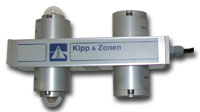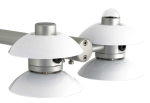This product is not available for new orders. We recommend ordering: CNR4-L.

| Services Available | |
|---|---|
| Repair | No |
| Free Support | No |
Overview
The CNR1 net radiometer by Kipp & Zonen is for applications requiring research-grade performance. The radiometer measures the energy balance between incoming short-wave and long-wave IR radiation versus surface-reflected short-wave and outgoing long-wave IR radiation. The CNR1 consists of a pyranometer and pyrgeometer pair that faces upward and a complementary pair that faces downward. The pyranometers and pyrgeometers measure short-wave and far infrared radiation, respectively. The CNR1 also includes an RTD to measure the radiometer’s internal temperature and a heater that can be used to prevent condensation. The CNR1-L cable length is built to order. For standard lead length of 82 ft, order CNR1.
If you need a mounting bracket for a CNR1 or CNR1-L, get advice by clicking the Ask a Question button on this page, or call 435-227-9000 and ask to speak to someone in our Flux group.
Read MoreImages

Detailed Description
The CNR1-L has a user-specified cable length. This net radiometer is for applications requiring research-grade performance. It measures the energy balance between incoming short-wave and long-wave infrared radiation versus surface-reflected short-wave and outgoing long-wave infrared radiation.
The CNR1 consists of a pyranometer and pyrgeometer pair that faces upward and a complementary pair that faces downward. The pyranometers and pyrgeometers measure short-wave and far infrared radiation, respectively. All four sensors are calibrated to an identical sensitivity coefficient.
The CNR1 also includes an RTD to measure the radiometer’s internal temperature, a 4WPB100 module to interface the RTD with the data logger, and a heater that can be used to prevent condensation.
The CNR1 uses six differential or four single-ended and two differential analog channels on the data logger. Data loggers that provide sufficient channels include our CR1000, CR3000, and CR5000.
If you need a mounting bracket for a CNR1 or CNR1-L, get advice by clicking the Ask an Expert button, or call 435-227-9000 and ask for someone in our Flux group.
Compatibility
Note: The following shows notable compatibility information. It is not a comprehensive list of all compatible or incompatible products.
Data Loggers
| Product | Compatible | Note |
|---|---|---|
| 21X (retired) | ||
| CR10 (retired) | ||
| CR1000 (retired) | ||
| CR10X (retired) | ||
| CR200X (retired) | ||
| CR206X (retired) | ||
| CR211X (retired) | ||
| CR216X (retired) | ||
| CR23X (retired) | ||
| CR295X (retired) | ||
| CR3000 (retired) | ||
| CR500 (retired) | ||
| CR5000 (retired) | ||
| CR510 (retired) | ||
| CR800 (retired) | ||
| CR850 (retired) | ||
| CR9000 (retired) | ||
| CR9000X (retired) |
Additional Compatibility Information
Do Not use the UT018 crossarm with the 14364 mounting bracket to fasten the CNR1 to a tower leg. The 14264 mounting bracket should be attached directly to a vertical pole.
Data Logger Considerations
Data Logger Requirements: Six differential or four single-ended and two differential analog channels.
Specifications
| Sensors | Kipp & Zonen’s CM3 ISO-class, thermopile pyranometer, CG3 pyrgeometer, PT100 RTD |
| Pyranometer Spectral Response | 305 to 2800 nm |
| Pyrgeometer Spectral Response | 5000 to 50,000 nm |
| Response Time | 18 s |
| Sensitivity Range | 7 to 15 μV W-1 m2 |
| Pyranometer Output Range | 0 to 25 mV |
| Pyrgeometer Output Range | ±5 mV |
| Expected Accuracy for Daily Totals | ±10% |
| Directional Error | < 25 W m2 (pyranometer) |
| Heating Resistor | 24 ohm, 6 W (at 12 Vdc) |
| CE Compliance | CE compliant under the European Union’s EMC directive |
| Operating Temperature Range | -40° to +70°C |
| Dimensions | 23.2 x 8.0 x 15.6 cm (9.1 x 3.1 x 6.1 in.) |
| Weight | 4 kg (8.8 lb) |
Documents
Brochures
Manuals
Frequently Asked Questions
Number of FAQs related to CNR1-L: 1
-
The CR1000 requires a 4WPB100 to measure the internal PRT. (Data loggers such as the CR3000 and CR5000 have the necessary PRT bridge module built in to measure the PRT.) Note that the CNR4-L also includes an internal thermistor, which can be directly measured by the CR1000. Because of this, when using a CR1000, Campbell Scientific typically recommends monitoring the internal temperature of the CNR4-L using its internal thermistor instead of the PRT.
Privacy Policy Update
We've updated our privacy policy. Learn More
Cookie Consent
Update your cookie preferences. Update Cookie Preferences


